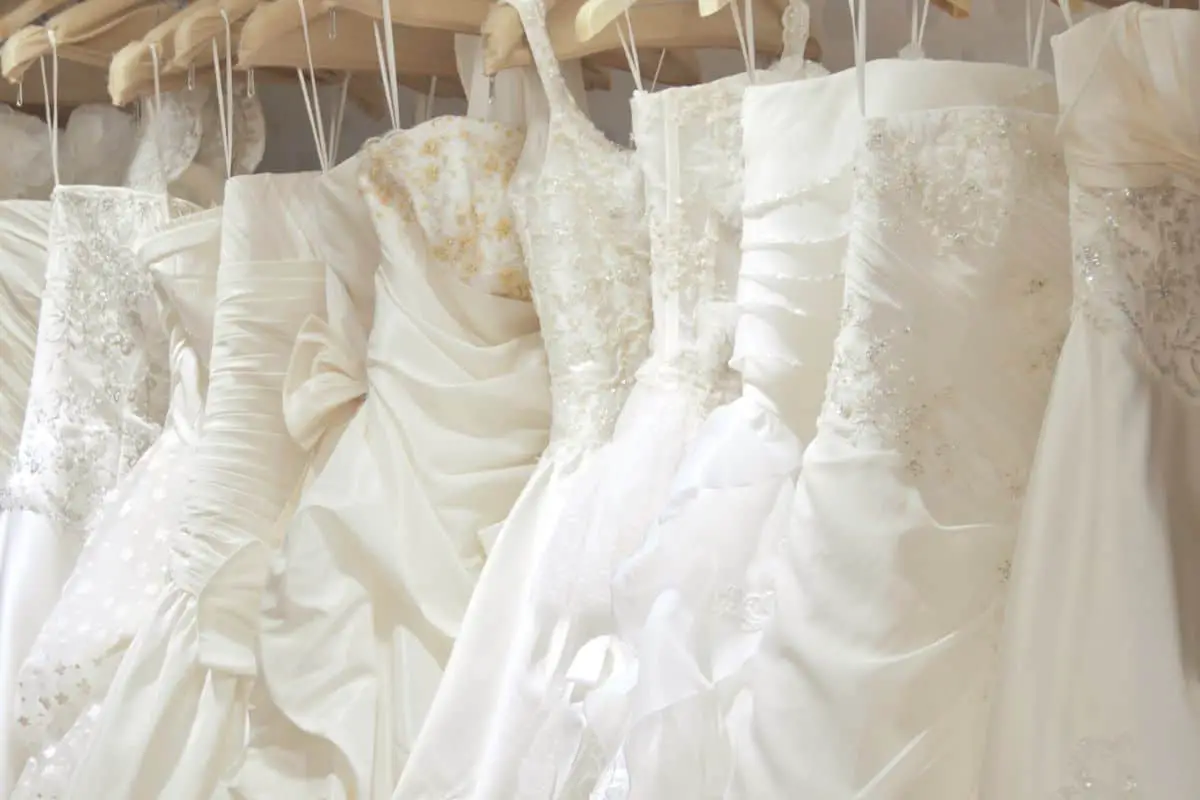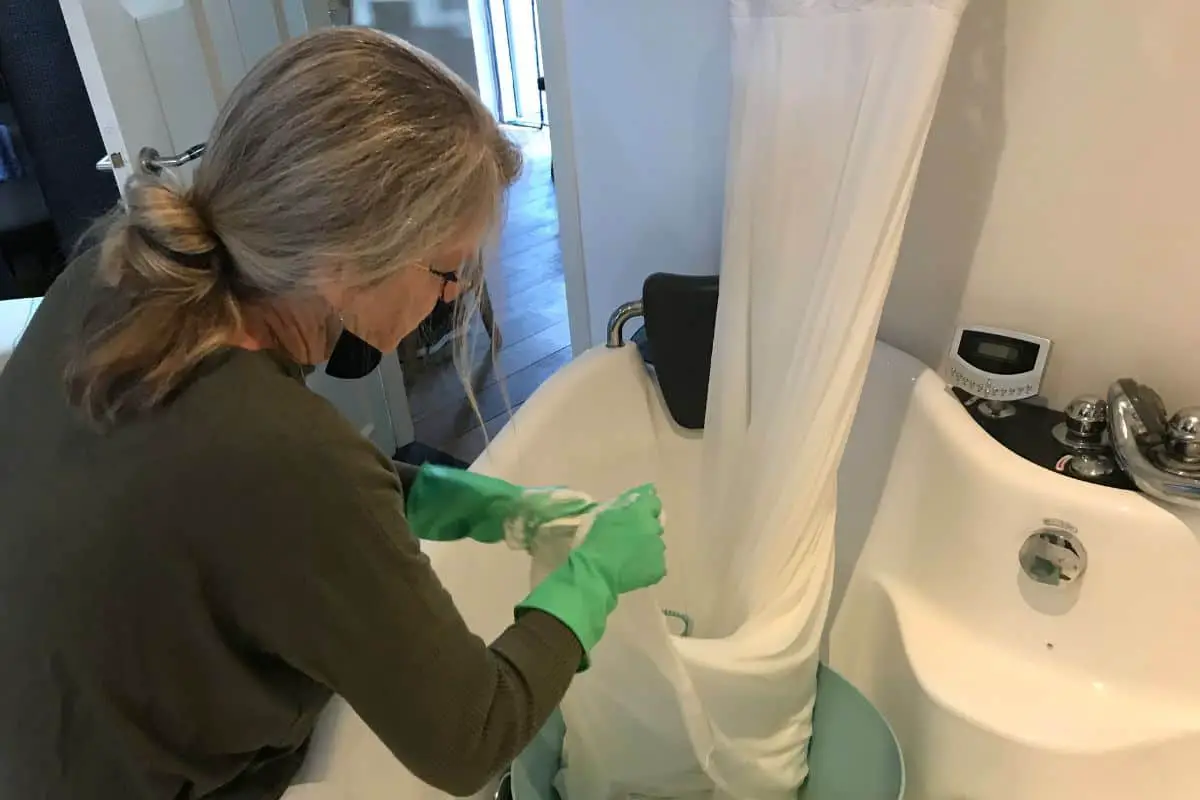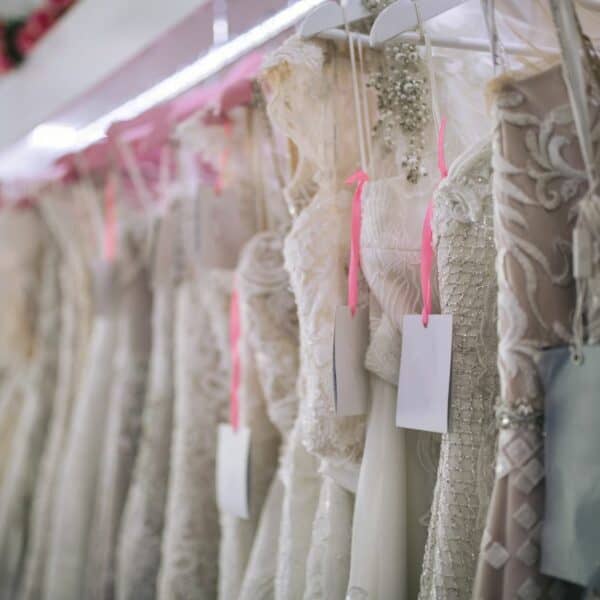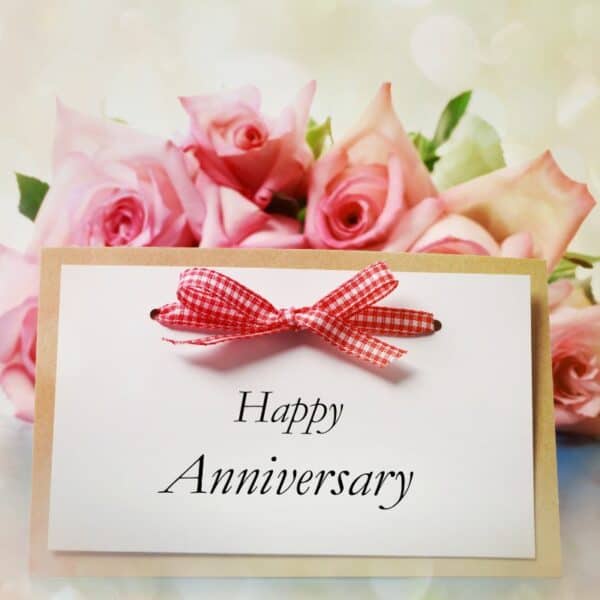After your wedding you carefully stored your wedding dress away somewhere safe. Then one day you take it out of storage, and suddenly your white wedding dress is yellow.
Don’t panic, your yellowed wedding dress can be whitened and restored to its original beautiful condition. There are reasons why this has happened and many of them are not something you can control.
We look at why white fabrics turn yellow, how to restore them and prevent the same thing happening again in the future.
We’ll also give you some tips on how to restore a vintage or antique wedding dress.
Why Does White Fabric Turn Yellow With Time?
If it is of any consolation, wedding dresses are not the only white garments or fabrics that tend to yellow over time. Most white and pastel shades of clothing and other fabrics are susceptible to yellowing.
The cause of yellowing in these fabrics is due to a breakdown of chemicals in the fabric. These are mostly colorless chemicals which when they begin to degrade start to turn yellow.
Over time this yellowing can become even darker, turning once white clothes brown or even black in places. This is chemical decomposition that has continued for many years most likely on an original stain that went unnoticed and uncleaned.
If the garment is then put into long term storage the likelihood is the chemical degradation will continue unnoticed and cause further staining.
Recent times have seen an increase in the amount of synthetic fibers in clothing and this raises the occurrence of yellowing in white and pastel colored fabrics.
With more synthetic fibers, there are more chemicals in the fabrics and so more chemical decomposition and degradation.
What Causes Wedding Dresses To Yellow?
With chemical breakdown being the major cause of white and pastel color fabrics yellowing it’s not surprising that wedding dresses can suffer the same fate.
But there are external factors that can further exacerbate or accelerate the problem of white wedding dresses turning yellow.
Degradation Of Fibers
The fibers in your wedding dress will naturally start to break down over time, but some environmental factors can increase the rate at which they degrade.
These environmental factors include storing the dress in direct sunlight, in high humidity or exposing it to high heat.
These factors will make the decomposition process accelerate, but it is the fiber degradation that is the biggest contributor to the yellowing of your wedding dress.
Chemical Additives
During the manufacturing process of both the material that comprises the wedding dress and the making of the dress itself chemicals will have been added.
There are different types of chemicals such as oils, chlorine and animal fats which may have been introduced into the manufacturing process as textile softeners.
These chemicals then begin to degrade and start to turn your wedding dress an unattractive shade of yellow.
However, the effect of these added chemicals in turning a wedding dress yellow can be accelerated and exacerbated by the incorrect storage of the dress.
In addition, while you were wearing the dress on your wedding day these same chemicals may have had the effect of drawing pollutants onto the fabric of your dress.
These pollutants can include dirt, oil and dust all of which can add to the problem.
Atmosphere Pollution
Pollutants in the atmosphere can contribute to the yellowing of your wedding dress, nitrogen in particular can have a detrimental effect on a white fabric.
The sources of this type of pollution are most commonly automobile emissions, household emissions from heating systems and other industrial processes.
Atmospheric pollution will typically only cause yellowing on the surface of the wedding dress.
Contaminants
Your wedding dress can become contaminated in storage even before you buy it. This could happen in the store or even where the dress was manufactured and will usually be invisible to the naked eye.
When the wedding dress is stored in plastic wrapping it causes something called phenolic yellowing. This can also occur if the dress is stored in cardboard or acidic paper.
When a white garment undergoes phenolic yellowing bright yellow patches will appear on the folded edges of the fabric.
This is different from other types of yellowing and is caused by nitrogen oxides interacting with phenolic or resin substances in storage materials.
The compounds that are formed from this interaction migrate through plastic, cardboard or paper onto the fabric of the dress.
In the absence of the plastic, paper or cardboard storage mediums it is possible that phenols have been added to the fabric in a dyeing process and this can cause yellowing.
However, the most common source of nitrogen oxides are automobile fumes.
Wedding Day Contamination
During your wedding day your dress will be exposed to all sorts of contaminants. From oils and lotions on your skin and hair to vehicle fumes as you travel to and from the ceremony and reception.
At the reception you will be eating and drinking, so there is an obvious risk of contamination from these sources.
There will also be things like dirt from the dance floor, tobacco smoke, and grass stains from outdoor photography shoots.
Of course, all of these activities are some of the most important parts of your wedding day, and you shouldn’t avoid them for the sake of keeping your wedding dress impeccably clean.
Just be aware, and after the wedding- have the dress professionally cleaned and stored.
How Long Before A Wedding Dress Turns Yellow?

So how long after your wedding will your once gleaming white gown begin to turn yellow? Well that will depend on a number of factors.
As we have advised, having your wedding dress cleaned after the big day is really important.
Even if it looks unmarked there will be, as we have discussed, invisible contaminants on the fabric which over time will start to cause yellowing in the fabric.
If you don’t have your gown professionally cleaned and stored correctly it will begin to yellow after as little as six months. Delicate fabrics such as chiffon and satin may go from yellow to a light brown in a few decades if not stored correctly.
The yellowing of the fabric will be speeded up if the wedding dress is stored in areas such as a hot attic, a damp basement or in direct sunlight.
As well as the yellowing of the fabric of your dress you may also get ‘spot scorching’. This is when a contaminant such as sweat, wine or sugar from your wedding cake gets onto the fabric but is not clearly visible.
Once the dress is in storage these stains turn into brown splotches as the fibers in the fabric break down.
Is It Possible To Restore A Yellowed Wedding Dress To White?
If you have taken your wedding dress out of storage and discovered that it has turned yellow in places what can you do to restore it?
Luckily there are things you can do to get your wedding dress back to its original color and remove the yellowing in the fabric.
The technology for cleaning delicate fabrics has come a long way and these processes can be used to restore your wedding dress.
Wet cleaning, dry cleaning and spot cleaning can all be used to remove the yellowing from your wedding dress. These processes can be applied to satin, lace and even silk to get the fabric back to its original white brilliance.
Without professional guidance it is not advisable to attempt to whiten your yellowed wedding dress yourself at home. Dunking it in a hot bath or even worse, bleach will have disastrous consequences for your wedding gown.
Leave cleaning your wedding dress to the professionals who have the knowledge, equipment and expertise to do the job properly without damaging the fabric of your gown.
How Cleaning A Yellowed Wedding Dress Works?
When you hand your wedding gown over to a professional cleaning service you may wonder how they go about getting your yellowed wedding gown back to its original color.
To ensure the fabric is not damaged as a consequence of the cleaning process, the professional cleaners take a structured approach to restoring your wedding dress.
Identify The Fabric
Before any action is taken to restore the gown, the type of fabric it is made from needs to be identified. This allows professional cleaners to understand how the fabric will respond to different cleaning products and processes.
The label may list the fabrics included in the wedding dress but sometimes on vintage dresses the label may be missing.
Silk is one of the most delicate fabrics and extra care needs to be taken when attempting to restore this material.
Assess The Fibers
Once the type of fabric or materials used in the makeup of the wedding dress have been identified, the cleaners will begin to assess the condition of the fibers.
Despite your best efforts to keep your wedding gown in good condition on your wedding day all sorts of outside influences will impact the fibers of the fabric.
The hem of your dress may have been dragged across asphalt or been stood on at your wedding reception.
The condition of the fibers in the fabric of your wedding gown can influence the products or processes that are used to clean it.
Gauge The Degree Of Staining

When professional cleaners begin working on the restoration of your wedding dress they will examine each stain on the fabric and grade each one. This allows them to assess the depth of every stain and decide how to proceed.
If the staining on the dress has begun to damage the fibers of the material then further treatment with cleaning chemicals may cause more damage. So the extent of each stain is gauged and a treatment plan formulated.
For staining that has advanced too far, it may not be possible to restore the gown.
Will Restoring A Wedding Dress Damage It?
If you attempt to restore a yellowed wedding dress yourself using household cleaning products or detergents then you run a high risk of damaging the fabric and any embellishments on the dress.
Bleach in particular is very destructive to the delicate fibers of your wedding gown and should be avoided.
You may get some results from soaking your dress in some warm water and detergent, but any deep stains will most likely need professional cleaning.
The system used by professional cleaners involves several stages. First they will engage in a gentle dry cleaning process followed by spot stain removal.
The garment will then be soaked and once clean it will receive a post treatment to protect it from future yellowing.
At all points, the dress is protected, and every care is taken to prevent damage to the fabric while restoring the original color. This procedure is effective even on vintage dresses that have become badly stained.
Tips For Cleaning Vintage Wedding Dresses

Many brides to be would love to wear a genuine vintage dress on their wedding day but the chance of finding one in pristine condition is slim.
So perhaps you’ve found one that has slightly yellowed, how do you go about cleaning it to make it wedding ready again?
Preparation
The first thing to do is remove any metal pieces on the dress. This can include hooks and eyes, zippers, buttons or snaps. You will need to soak the dress and leaving these on will cause them to rust and stain your dress.
Spot Cleaning
Next you will need to carry out any spot cleaning. The material that the dress is made from will determine which products you can safely use.
Satin and silk are delicate fabrics needing gentle cleaning whereas polyester is a much tougher material.
Mix some mild detergent and a light stain remover in a spray bottle and test it on an inconspicuous part of the dress to make sure it’s safe and not going to react with the fabric.
Then work your way around the dress treating any stains.
Soak The Dress
Fill a bath with warm water and pour in some mild detergent, Woolite or something equally gentle. Depending on the material the dress is made from you can also add some stain removing powder or liquid.
Agitate the water to mix everything together and put the dress into the bath, making sure it is completely submerged.
You can leave it to soak for between four and twenty four hours depending on the fabric type and the extent and depth of the staining.
If the water becomes yellow, empty it out and refill the bath with a clean mixture. Once the soaking period is over, remove the dress, empty the bath and refill just with warm water.
Rinse the dress in this clean water, then repeat, again in warm water.
Finally, fill the bath with cold water and give the dress a final rinse. When you take the dress out it will be very heavy so be careful not to rip any of the delicate fabric. Dry the dress on a flat surface so that it doesn’t lose its shape.
Restore The Removed Items
When the dress is completely dry you can reattach all the metal components that you took off prior to cleaning.
How To Stop A Wedding Dress Yellowing In The Future
Most yellowing and staining comes from contaminants that may not be visible on the surface of the fabric.
Over time these start to break down the fibers of the material and some stains will oxidize and create the appearance of patches on the dress.
The best way to prevent your wedding dress from going yellow is to have it professionally cleaned as soon as possible after the wedding.
However, cleaning the dress does not guarantee that it will be protected against yellowing, although it is an essential first step. Incorrect storage can still cause your dress to turn yellow.
To be sure that your wedding gown is kept in the best possible condition you should consider using the services of a reputable wedding dress preservation company.
Wedding dress preservation is not the same as wedding dress cleaning, however. To preserve a wedding gown it must first go through the cleaning process of wet cleaning, spot cleaning and stain removal.
It is then pressed to remove any folds in the material.
What separates preservation from cleaning is the application of a protectant to the wedding dress. This will guarantee that no yellowing or staining will occur. It also acts as a moisture repellant.
The dress can then be preserved in an acid free display chest to further protect it.
In Conclusion
Your wedding day is one you will look back on with fond memories, and you may want to keep your wedding dress for future generations. To do this you will want to make sure it doesn’t yellow over time.
We hope this guide has helped you to understand the process of wedding dress restoration after yellowing has occurred.
- Full Breakdown: How Much Does Your Dream Disney Wedding Really Cost? - April 13, 2023
- Magical Beginnings: 11 Steps for Planning Your Dream Disney Wedding - April 8, 2023
- 40 Unique Gifts For Daughter On Her Wedding Day - March 25, 2023




Leave a Comment